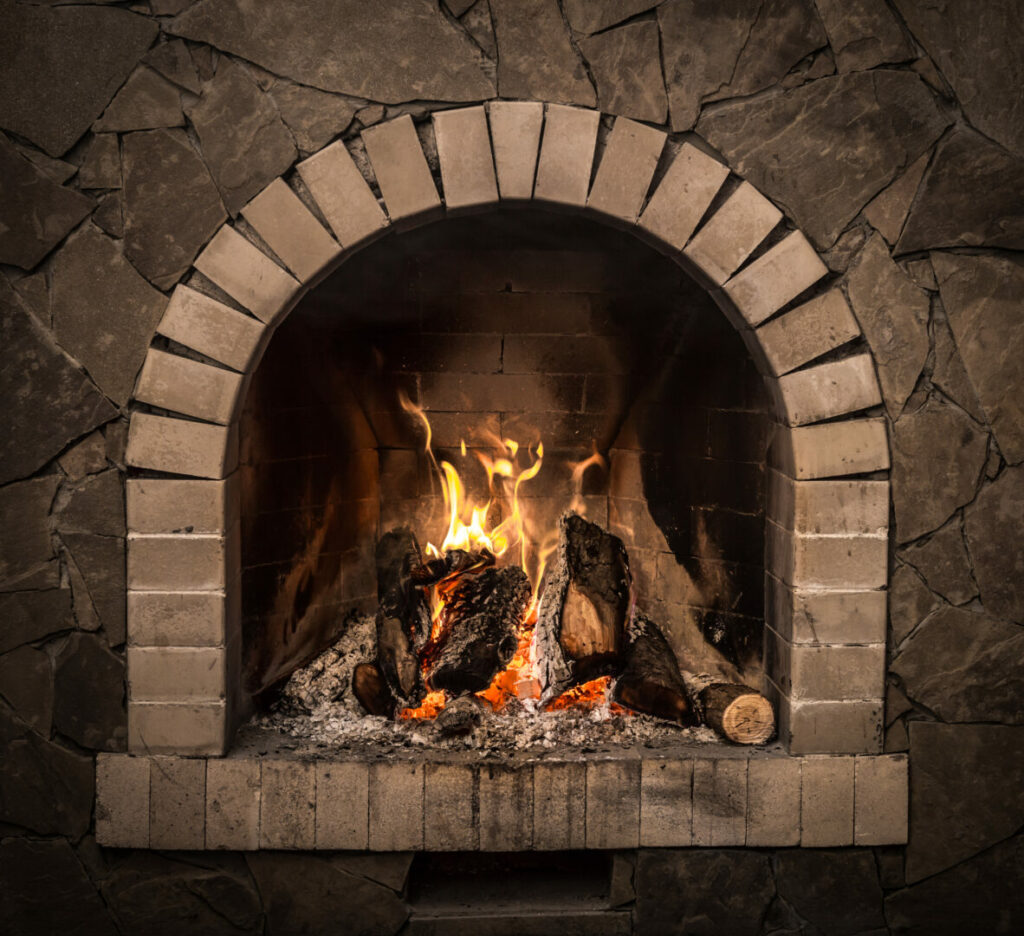1. Read your Fireplace Manual!
Many people fail to do this. You can use your manual to learn how to clean and maintain your fireplace. It might teach you the best ways to use your fireplace, so it burns well and produces the least amount of smoke. It might also inform you about the best accessories to use with your fireplace, so you get the most out of it. If you don’t have your manual, you can find the manual’s website by searching for the fireplace model, brand, or name.
Some of the most common causes of smoke backfilling into the house stem from a lack of experience from the homeowner. People can make simple mistakes that can cause large plumes of smoke to fill the house from the fireplace. These mistakes can be avoided quite easily. All a person needs to do is think a few steps ahead and be ok.
Common mistakes can be avoided by keeping these tips in mind:
- Ensure that the smoke has a place to go and will not backfill the home
- Know the capabilities of the chimney and do not start fires too fast
- Ensure that proper precautions have been taken to limit the amount of smoke that could enter the home
The flue must be opened all the ways. Even a partial obstruction could result in tons of smoke filling the house. People often overlook this step, mainly when they have used the fireplace recently with no issues. It is possible that the flue could have shifted since it was last used. It takes less than a minute to take care of this concern. Do it.
A huge reason that smoke comes back into the house is the process of back-drafting. This can occur when the homeowner fails to warm the air within the chimney before starting a fire. On freezing days, a homeowner hoping to make a fire should light a small piece of wood or a rag and hold it in the fireplace as the heat climbs.
People need to take the time to do these little things right. By ensuring that the flue is adequately opened and that the chimney has had a chance to warm up, the homeowner is going the extra distance to ensure that their home will not fill up with smoke. It will save a world of trouble down the road and probably takes five minutes altogether.
2. Install a quality carbon monoxide detector
You should have one in your home, especially if you have a fireplace. Carbon monoxide is an invisible, odourless gas that can kill you. It can be produced by your fireplace, even if the fire is small. When the fireplace is burning, the CO levels can increase in your home. You can install a CO detector near the fireplace or in the home. If you have small children or older adults living in your home, you should have a CO detector near the fireplace.
3. Have windows and doors open when you burn anything
You should always have open windows and doors when you burn anything in your fireplace. Burning logs, Wood, or anything else produces a lot of smoke. This smoke can quickly build up in your room, filling it with smoke. The smoke can easily escape if the windows and doors open. When you have the windows and doors open, make sure you have a fan blowing the smoke outside, so it doesn’t end up in other parts of your house.
4. Add an exhaust fan to your chimney
An exhaust fan helps your fireplace produce less smoke while burning. An exhaust fan can be installed inside your chimney, near the fireplace. If you have an old fireplace, you can buy an inexpensive fireplace insert, which is a perfect place to install the exhaust fan. When you have an exhaust fan, it will help draw smoke out of your house and send it up the chimney. This will help prevent smoke from building up in your home when you’re burning fire and is a must-have for any homeowner with an open fireplace.
5. Select the right Wood
The first-place people go wrong when making a fire for the fireplace is by selecting the wrong wood. Selecting the suitable Wood can reduce the amount of smoke you have to deal with. The wood they use should be something that is not gummy like pine, and it should be scorched. Many types of Wood produce less smoke than others, like cedar, maple, oak, and birch. Using wood not up to a certain standard will create loads of smoke that will backfill the house. This should be avoided.
The three most effective wood types to use in the fireplace for the best results are:
- Properly aged, dry oak that is free of dirt and debris
- Maple oak that has had time to dry and hold no troublesome moisture
- Birch wood with the bark on will look great in the fireplace
Pinewood should be avoided at all costs. Certain woods like pinewood produce a lot of smoke, while others don’t. If you use Wood that produces a lot of smoke, you’ll likely have to deal with smoke a lot more often. You can also find Wood that contains no bark or very little bark. It is not an acceptable source of firewood for the fireplace. The soot produced from pinewood contains highly flammable resin. This can kick smoke back into the house quickly and cause the home to burn. Choosing the proper type of wood is essential to success.
If the wood has sat outside for a while, the fire maker should ensure that it has first had a chance to dry completely before finding its way into the fireplace. The moisture in the wood can cause excess smoke to fill the chimney and pour into the house. Removing the bark is the best way to ensure the wood is properly dried. This will dry it fast!
A significant cause of smoke can come from debris that the wood has gathered while being stored. This debris can be paper, dried grass, spider webs, and anything. When the debris on the outside of the wood meets the flame, it is possible that excess smoke can be created, which will tend to pour back into the house unsafely. You should consider using less smoky woods to enjoy your fireplace without dealing with lots of smoke
6. Consider attaching a venting system to your fireplace
If you have an old fireplace and want to prevent smoke from filling up your room, you might want to consider attaching a venting system to your fireplace. Many older fireplaces don’t have a flue and don’t produce much if any, smoke when burning. Newer fireplaces, on the other hand, produce a lot of smoke. If your fireplace doesn’t have a flue, you can use a stove pipe to connect your fireplace to your chimney. Connecting your fireplace to your chimney will allow the smoke to escape. It will also prevent the smoke from building up in your home.
7. Make sure your flue is at the right temperature
If you don’t have a wood-burning fireplace, you might not know how to keep it from smoking. But if you have a wood-burning fireplace, there are things you can do to reduce the amount of smoke it produces. You can make sure your flue is at the right temperature. The right temperature will prevent too much smoke. When you open your flue, it’s like opening a door. This causes your fireplace to smoke a lot. You can open your flue and close the door when you want the fireplace to smoke. Ensure your flue is at the right temperature to prevent too much smoke. The chimney will have trouble creating a good draft if the flue temperature is like the air outside. This is when the chimney releases the smoke and fumes from the fire while simultaneously taking in the fresh air. When this process is interrupted, the excess smoke will more than likely wind up in a person’s house, which can be troubling.
The ideal temperature range between the inside and outside air should be around 20 degrees. Waiting to start a fire until there is a significant difference between the two will ensure that smoke does not come backfilling from the chimney into the home. This could be very dangerous.
- A rolled-up newspaper could be held and burned easily
- A tightly twisted rag on a stick or fire poker would work very well
- A candle could work in a pinch, but it might require more time to warm the air
- Tightly wadded and twisted bunches of straw or dry grass
- Cardboard could work very well since it is made of flammable paper
If the air within the flue is too warm, smoke could also pour into the house. To fix this, a person should lower the temperature on the thermostat to bring the heat down in the home. This is probably the fastest way to reduce the flue’s temperature and ensure enough differentiation with the air inside the flue to mitigate smoke.
8. Perform Regular Maintenance
You can prevent smoke from filling your room by regularly maintaining your fireplace. To prevent smoke from filling up your room, you should inspect your fireplace once a year. A dirty chimney can pose severe risks to a person and their home. Obstructions caused by built-up soot and debris from fires can lead to a build-up of smoke that will have no other exit than back through the house. This can be easily avoided by proper upkeep and maintenance. Do the little things now before they become big things later.
The main types of maintenance tasks that can prevent smoke will benefit the user by ensuring:
- Their home stays free of damage from backfilled smoke
- Their family remains healthy without exposure to toxins from the smoke
- That everyone has a pleasant experience on days that the fireplace is used
- That their clothing does not allow reek of the smell of wood smoke
- That their electronics do not sustain damage from the smoke
Good maintenance is the best defence to use. Soot and debris from fires can build up and cause the flue to become obstructed or flammable. This is a considerable risk to the home and the homeowner as well. Hiring a chimney sweep to clean out this gunk and debris is a great way to mitigate the chances of smoke backfilling into the home.
A great way to reduce the risk of smoke filling the house is to cap the chimney in the off-season. This will keep the flue free from obstruction and debris from the outside. This will be a complete obstruction and cause all the smoke to backfill. A homeowner must remember to remove the cap before they make fire, though.
To ensure that the chimney, fireplace, and various components are in working order, it is a good idea to have them inspected before the season and after. This will keep the fireplace, chimney, and components in good working order and significantly reduce the chances for the smoke to backfill the home.
During this inspection, you should look for issues, like cracks in your fireplace, lint, soot or dust buildup in your chimney, and more. You should also clean your fireplace so it burns well and doesn’t produce too much smoke. You can clean your fireplace by sweeping out the ash and then sweeping the inside with a broom. You can also vacuum the inside.
How to Get Rid of Fireplace Smell (When There’s No Smoke)
If someone cannot prevent smoke from accumulating in their house, they can face another problem after clearing it out. The scent of a fire can linger in a home for ages and leave everything covered in an invisible film of grime. There are a few ways to remove the smell and grime from homes contaminated with toxic smoke.
An excellent method for removing the smell of smoke from home is to mix vinegar and water and use it as a cleaning agent. This works well on hard surfaces and can directly apply to the flue. Vinegar and water do not mask the odour. The mixture will remove the odour from most, if not all, surfaces.
To remove the lingering scent from the air, a homeowner should use baking soda and water. The homeowner should place this mixture in bowls around the house to get the scent of smoke out of the room. This is an excellent remedy for those who find the scent of vinegar more off-putting than the scent of smoke and ash from the fireplace.
The charcoal briquettes have a natural quality to filter out foul smells. To attack the scent at its source, the homeowner should also place charcoal briquettes in a bucket or receptacle with damp paper towels. The damp paper towels will help to attract the odour to the charcoal. This will be a great way to attack the odour at its most vital point.
Conclusion
These are five ways to prevent smoke from filling your room after buying a fireplace. By reading your fireplace manual, installing a quality carbon monoxide detector, having windows and doors open when you burn anything, adding an exhaust fan to your chimney, and selecting suitable Wood, you can prevent smoke from filling your room after buying a fireplace. You should also maintain the fireplace, so it doesn’t produce too much smoke.
Smoke can quickly build up in a home and cause the occupants to become ill. Backfills of smoke can be avoided by following the steps listed above. It is as simple as taking the time to do the little things the right way. Homeowners that take the time to do those little things the right way will mitigate their risks of smoke backfill.
Keeping smoke from backfilling, removing it from the house, and eliminating lingering odours can all be confusing tasks. The good news is that these things can be done relatively quickly when a person takes the time to ask how. This guide will include everything a homeowner needs to use and enjoy their fireplace correctly. Good luck and stay safe!









